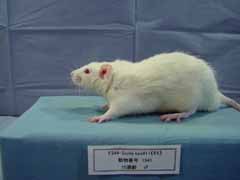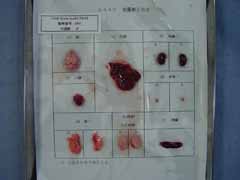| NBRP Rat No: 0455 |
Strain name: F344-Scn1am1Kyo |
Commmon Name: F344/NSlc-Scn1aKyo811 |
Rat Genome Database |
| Principal Investigator: |
Tadao Serikawa Graduate School of Medicine, Kyoto University Yoshidakonoe-cho, Sakyo-ku 606-8501 Kyoto JAPAN |
| Tel: 075-753-4360 Fax: 075-753-4409 |
Email: serikawa@anim.med.kyoto-u.ac.jp |
| Preservation Status: |
Embryo Sperm Living Animals |
 |
 |
| Coat Color |
albino (c) |
| Inbred Generations |
N11F5 (April 2012) |
| Usage Restrictions |
The recipient of BIOLOGICAL RESOURCE shall obtain a prior written consent on use of it from the DEPOSITOR.
For a commercial use of this resource, a new contract must be concluded between the depositor and the recipient. |
| Genetic Status |
|
| Comercial Availability |
|
|
| Research Category |
|
| Gene Affected |
Scn1a: sodium channel, voltage-gated, type I, alpha |
| Origin |
This strain was established by ENU mutagenesis (gene-driven). This strain possesses a point mutation in the Scn1a gene (N1417H) (Mashimo, 2010). Hyperthermia-induced seizure-susceptible (Hiss) rat. (May 26, 2010) |
| Strain characteristics |
A point mutation in Scn1a gene.
This strain possesses a missense mutation (N1417H) in the third pore region of the sodium channel, Scn1a. Despite their normal appearance under ordinary circumstances, Scn1a mutant rats exhibited remarkably high susceptibility to hyperthermia-induced seizures. Scn1a is a causative gene for human GEFS+. Immunohistochemical analysis revealed that hyperthermic seizures induced a widespread elevation of Fos-immunoreactivity in the cerebral cortices and limbic regions (Ohno, 2010). This rat showed a significantly lower threshold in epileptiform discharges in response to local stimulation of the hippocampus. Diazepam and sodium valproate are effective to hyperthermic seizure of this rat (Ohno, 2010). (Oct 11, 2010) |
| Breeding Conditions |
Good breeding performance. |
| Genotyping |
Genotyping protocol for Scn1am1Kyo |
| References |
Ohmori I, Kobayashi K, Ouchida M.
Scn1a and Cacna1a mutations mutually alter their original phenotypes in rats.
Neurochem Int. 2020 Dec:141:104859.
Serikawa T, Mashimo T, Kuramoto T, Voigt B, Ohno Y, Sasa M.
Advances on Genetic Rat Models of Epilepsy.
Exp Anim. 2015 Feb 5;64(1):1-7.
Ohmori I, Kawakami N, Liu S, Wang H, Miyazaki I, Asanuma M, Michiue H, Matsui H, Mashimo T, Ouchida M.
Methylphenidate improves learning impairments and hyperthermia-induced seizures caused by an Scn1a mutation.
Epilepsia. 2014 Oct;55(10):1558-67.
Ohmori I, Hayashi K, Wang H, Ouchida M, Fujita N, Inoue T, Michiue H, Nishiki T, Matsui H.
Inhalation of 10% carbon dioxide rapidly terminates Scn1a mutation-related hyperthermia-induced seizures.
Epilepsy Res. 2013 Jul;105(1-2):220-4.
Ohno Y, Ishihara S, Mashimo T, Sofue N, Shimizu S, Imaoku T, Tsurumi T, Sasa M, Serikawa T.
Scn1a missense mutation causes limbic hyperexcitability and vulnerability to experimental febrile seizures.
Neurobiol Dis. 41(2):261-269, 2011.
Hayashi K, Ueshima S, Ouchida M, Mashimo T, Nishiki T, Sendo T, Serikawa T, Matsui H, Ohmori I.
Therapy for hyperthermia-induced seizures in Scn1a mutant rats.
Epilepsia 52(5):1010-1017, 2011
Ohno Y, Sofue N, Ishihara S, Mashimo T, Sasa M, Serikawa T.
Scn1a missense mutation impairs GABA(A) receptor-mediated synaptic transmission in the rat hippocampus.
Biochem Biophys Res Commun. 2010 Sep 10;400(1):117-22.
Mashimo T, Ohmori I, Ouchida M, Ohno Y, Tsurumi T, Miki T, Wakamori M, Ishihara S, Yoshida T, Takizawa A, Kato M, Hirabayashi M, Sasa M, Mori Y, Serikawa T.
A missense mutation of the gene encoding voltage-dependent sodium channel (Nav1.1) confers susceptibility to febrile seizures in rats.
J Neurosci. 2010 Apr 21;30(16):5744-53. |
| Additional strain information |
|
|
|